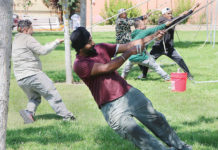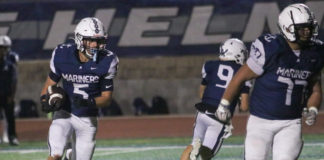
WATSONVILLE—In the coming weeks, students at Watsonville High School—along with school administrators, teachers and parents—will join forces to hammer out a new dress code, a set of policies all parties hope will promote campus safety and encourage a modicum of decorum while still allowing students to express themselves through fashion.
But the school year did not start off on such a cooperative note.
Instead, on the Friday before school started students found that a new dress code had already been created for them—entirely without their input—and containing rules they found disturbing or downright unnecessary.
And so the students banded together, circulating a petition among their peers, talking to school administrators and addressing the Pajaro Valley Unified School District Board of Trustees. And the school listened.
The new rules—more restrictive and specific than previous ones—seemed largely to focus on what female students could wear, says junior Bella Umeki-Martinez.
This included limiting shorts and skirts to a minimum of 5 inches and banning see-through tops, underwear worn as outerwear and strapless shirts. Shirts that show midriffs were similarly forbidden.
“It was mostly targeting women and the female body,” Umeki-Martinez said.
The code also banned baggy pants and belts hanging below the shirt hem. In addition, hats with red or blue made the list, as did rosaries with black, red or blue.
Law enforcement officials say that criminal street gangs are known to identify themselves with those colors, but the students say such a rule is misguided, since most gang activity doesn’t take place on campus.
“We felt a bit that it was criminalizing our students,” Umeki-Martinez said. “I understand they want to keep us safe, but I think the only problem was that it wasn’t communicated effectively. We know we live in an area where there is more gang activity than other schools, but it felt that they were saying any student who wears red or blue must be affiliated. That’s how it came off to us.”
Alvaro Felix, 16, agreed, and added that the policy against rosaries appeared to attack the Hispanic and religious community.
“We thought targeting religion was kind of inappropriate, considering this is America,” he said.
Indeed, federal courts have ruled that banning students from wearing rosaries infringes on their First Amendment rights to express their religion.
Further, while many schools such as Soquel, Aptos and Pajaro Valley also seek to curb gang issues among their students by prohibiting certain colors—and to stop them from showing affiliation to criminal street gangs by wearing them—there is little empirical evidence supporting the notion that doing so has any impact on violence.
“I don’t think it’s ever been a school problem,” Felix said. “It doesn’t involve colors. It never has.”
Morielle Mamaril, 17, the ASB co-president, says that policies going after what students wear is not addressing the real problem of gangs in schools. Instead, she says, the school should dig deeper, offering expanded counseling services and other help.
Concerns about the particulars of the dress code aside, Felix says that students’ main concern was that they were not included in the creation process.
“More inclusivity is exactly what we needed,” he said. “There’s only one way to really fix this issue—and that’s with the student body and the parents and the community. The fact that they are taking student input, we deeply appreciate that.”
Senior Fernanda Jordan says that many students felt they were being treated like children, particularly the admonition in the code prohibiting bare feet.
“Because at the end of the day, we are young adults, and we know not to come to school without shoes,” she said.
Principal Clara Fernandez says that the new rules will be more student-centered while focusing on keeping them safe.
“Ultimately the goal is to have a dress code that is appropriate and that does not discriminate against any particular viewpoint or result in any disproportionate application based on student gender or sexual orientation,” she said. “Hopefully we can come together and create an equitable and well-implemented dress code where students feel that they have the right to self-expression, while keeping safety at the core, because that’s really what the intent is.”
While the controversy was growing in the first days of school, Assistant Principal Jeff Daucher added fuel to the fire with comments made to students about the dress code.
In a recording made by a student, Daucher could be heard asking what message female students are sending to their male counterparts with what they wear.
He also says in the recording that girls who wear clothes showing their midriff should first have “abs,” Umeki-Martinez says.
That reaction from a school official disturbed many students.
“When he sees a girl wearing an outfit like that, it’s like an invitation for boys and him to make advances,” she said. “So it was the message behind the dress code which the students were upset by.”
PVUSD officials are not commenting on the matter, since it involves personnel issues. In a letter sent to parents, district officials say that Daucher’s statement “was not aligned with our community beliefs.”
“I have spoken to the individual to ensure they understand the impact of the statement and we are committed to ensuring that we continue to address comments that could disrupt the learning environment,” the letter read.
In advance of the upcoming talks, students are invited to fill out an online survey to help participants shape the new policy.
“Now we can move forward and create better change in the future,” Umeki-Martinez said, adding that she hopes the new model of creating school-wide policy could inspire other schools to do the same. “We could possibly see a very positive change collectively.”












Dress codes intrinsically relate to gender. Since there are now more than a dozen identified genders, it seem a fruitless task to try to assign corresponding codes for dress. I suggest letting student wear what they want. I would hope they would choose to conform to their family’s standards.
that makes sense, Pickles.
Wonder why student input wasn’t solicited. Sure would have made sense. Would have been a great way for the assistant principal to meet and get to know students.